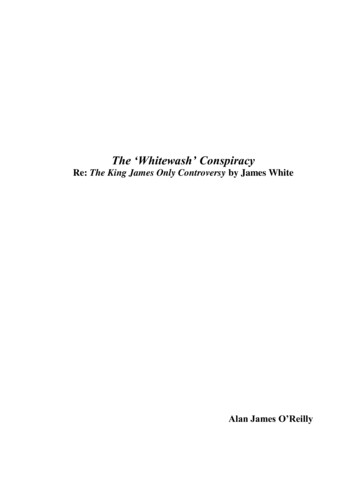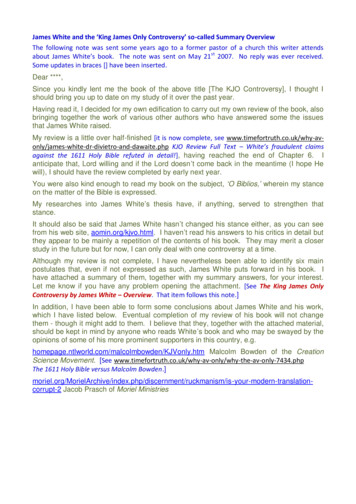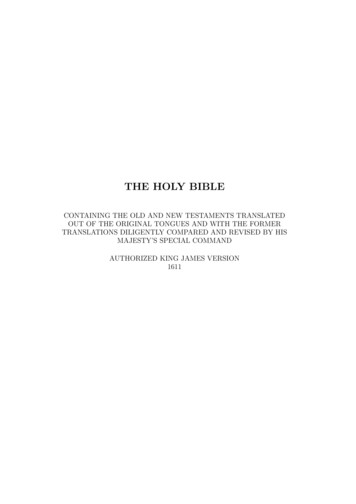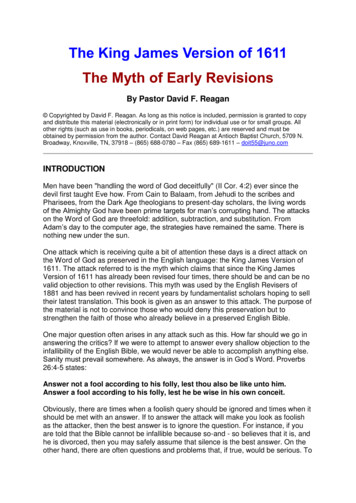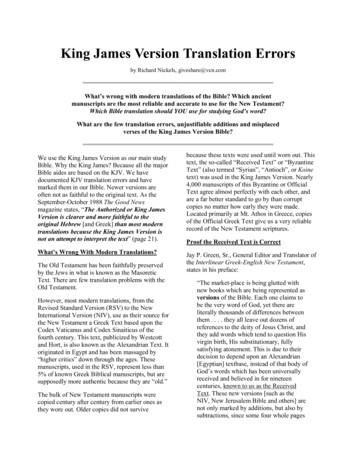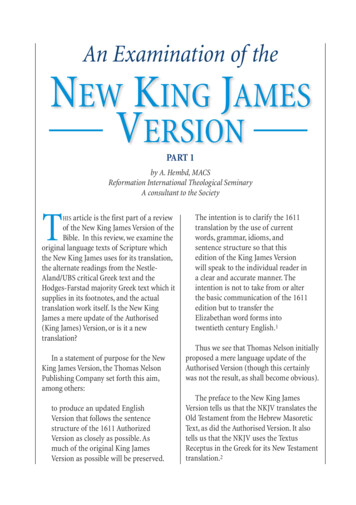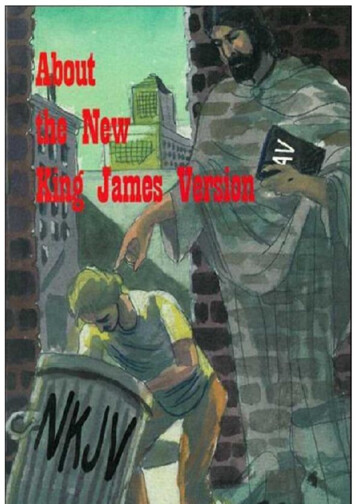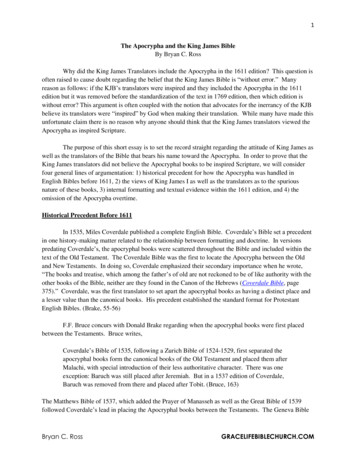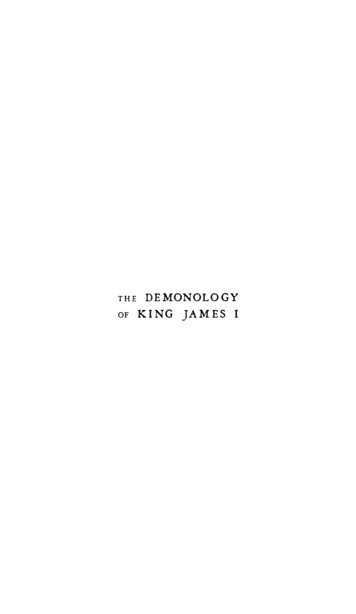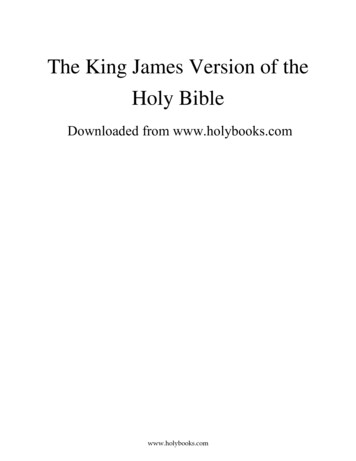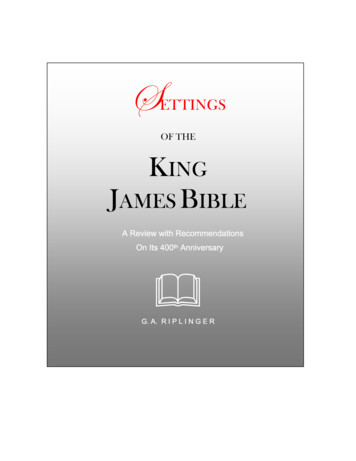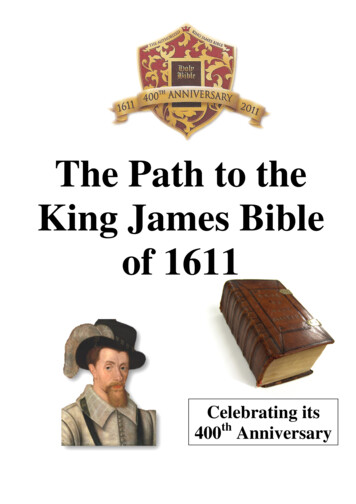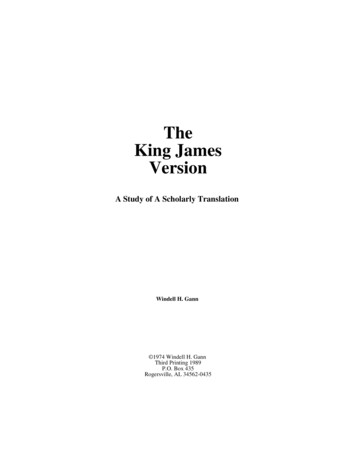
Transcription
TheKing JamesVersionA Study of A Scholarly TranslationWindell H. Gann 1974 Windell H. GannThird Printing 1989P.O. Box 435Rogersville, AL 34562-0435
The King James Version(A Scholarly Translation)Table of Contents PageI.History . . . . . . . . . . . . . . . . . . . . . . . . . . . . . . . . . . . . . . . . . . . . . . . . . . . . . . .3II.Early Editions . . . . . . . . . . . . . . . . . . . . . . . . . . . . . . . . . . . . . . . . . . . . . . . . . . 5III.Reception of the King James Version . . . . . . . . . . . . . . . . . . . . . . . . . . . . . . . . 6IV.The Greek Text of the King James Version . . . . . . . . . . . . . . . . . . . . . . . . . .V.Points of Scholarship . . . . . . . . . . . . . . . . . . . . . . . . . . . . . . . . . . . . . . . . . . . . 1281.The number, scholarship, and predisposition of the translators . . . . . . . . . . . . . . . . . . . . . . . . . . . . . . . . . . . 122.No sectarian features. . . . . . . . . . . . . . . . . . . . . . . . . . . . . . . . . . . . . . . 123.Supplied words noted. . . . . . . . . . . . . . . . . . . . . . . . . . . . . . . . . . . . . . . 134.Translating the tetragrammaton . . . . . . . . . . . . . . . . . . . . . . . . . . . . . . . . 135.Verse notations and ¶ markings . . . . . . . . . . . . . . . . . . . . . . . . . . . . . . . . 146.Translating the present indicativethird person singular . . . . . . . . . . . . . . . . . . . . . . . . . . . . . . . . . . . . . . . .7.15Translating the second person pronounsingular and plural . . . . . . . . . . . . . . . . . . . . . . . . . . . . . . . . . . . . . . . . . . 15VI.Criticism of the King James Version . . . . . . . . . . . . . . . . . . . . . . . . . . . . . . .17VII.Conclusion . . . . . . . . . . . . . . . . . . . . . . . . . . . . . . . . . . . . . . . . . . . . . . . . . . . . 18Bibliography . . . . . . . . . . . . . . . . . . . . . . . . . . . . . . . . . . . . . . . . . . . . . . . . . . . . . . . .19Appendix A Chart of the English Bible . . . . . . . . . . . . . . . . . . . . . . . . . . . . . . . . . . .21Appendix B The Lord's Prayer in Historic Versions . . . . . . . . . . . . . . . . . . . . . . . . . . 22
The Scholarship of the King James VersionPage 3The King James VersionI. HistoryThe colorful sixteenth century came to an end with the death of QueenElizabeth I in 1603. The English Church was now definitely separated from theChurch of Rome; England and Scotland were united under the crown of King JamesI; English literature was bursting into full flower with Shakespeare, Bacon, andSpenser. One of the first tasks which King James faced was the reconciliation ofvarious religious parties. One of their more serious differences of opinion was overthe Bible versions. The Bishops' Bible and the Great Bible were in use in thechurches, but the Puritans, who were in ascendancy, were buying the Geneva Bible.The Bishops' Bible was the Authorized Version but it was a poor translation. KingJames liked the Geneva Bible as a translation but the many marginal notes whichattacked the King were objectionable. No one knew just what faction James woulduphold.In January 1604, King James called a conference of leading religious leadersat Hampton Court to promote religious toleration. Amid the discussion, Dr. JohnReynolds, President of Corpus Christi College, Oxford, spokesman for the Puritangroup, proposed a new translation that would have the approval of the whole church.Most present took little notice of the suggestion with the exception of King Jameswho was himself somewhat a Bible scholar and had even done some translation.On July 22, 1604, the king announced that he had appointed 54 men astranslators of new version. The list included Anglican churchmen, Puritanchurchmen, linguists and theologians (including some who were uncommitted toeither religious party), laymen and ministers. And these translators had the privilegeof calling on any scholar outside their committee if they should desire.A list of 47 of the men has been preserved with the company they served. Theother seven appear to have died or resigned before the work began. One of the mostvaluable Hebrew scholars, Dr. Lively, died in 1605 before the translating workstarted. (Hills, p. 21)
The Scholarship of the King James VersionPage 4The Revisers were organized into six companies; two meeting atWestminster, two at Cambridge, and two at Oxford. The companies were made upof seven or eight of the greatest Hebrew and Greek scholars of the day. Eachcompany was given a section of scripture with which to start. Each man made hisown translation and they then compared and revised them into one version whichthen went to each of the other companies for review. Thus every part of the Biblewent through the hands of the entire body of revisers. Then the entire version, thus,amended, came before a selected committee of twelve, two from each company. Theyironed out ultimate differences and put the finishing touches, the harmonisticelements, upon the work and prepared it for the printer. (Miller, p. 364)The King gave the revisers a set of 15 rules to govern their work. A gist ofa few of them being:1.The Bishops' Bible shall be followed and as little altered as the truth of the originalwill permit.2.The old ecclesiastical words shall be retained.3.The chapter divisions shall not be changed, unless very necessary.4.No marginal notes at all, except explanation of Hebrew and Greek words whichcannot be briefly and fitly expressed in the text.5.Whenever the Tyndale, Matthew, Coverdale, the Great Bible, or the Geneva agreesbetter with the text than the Bishops' Bible, they are to be used.[See McClintock and Strong, Vol. 1, p.560 for full list.]II. Early EditionsThe translation was proposed in January 1604, began in 1607, took twoyears to accomplish and nine months more to prepare for the printer. The first editionappeared with an engraved title page, a dedication to King James, a Preface to theReader, genealogies, maps, and other popular features. The engravings were from
The Scholarship of the King James VersionPage 5previously published Bibles and classic books. The pages were unnumbered but therewere 1668 of them. It was a stately folio edition measuring 16 x 10½ inches, and wasintended to be a "pulpit" edition.There is no evidence to show that the version ever had the official approvalor authority of King James. Evidently the printers on their own authority had beenusing the phrase "Authorized and Appointed to be Read in the Churches" on copiesof the Bishops' Bible to distinguish it from the Geneva Bible. They continued thesame use with the new version. Thus the phrase "Authorized Version" used as a labelto distinguish it from other versions was not a historical reality. It appears that theking never even made a contribution toward financing the operation.Three editions of the KJV appeared during the first year. In the next threeyears fourteen editions in various sizes were printed. As to be expected under earlyprinting methods, there were many typographical errors in every edition. As old oneswere corrected, new ones appeared. Some were quite humorous and some serious.One of the 1611 editions had "I Corinthians" and "2 Corinthians" listed inthe Old Testament instead of Chronicles. But of all the misprints the KJV suffered,none were as scandalous as the omission of the word "not" from the seventhcommandment, hence the offending edition was commonly called the Wicked Bible.Another edition was called the Vinegar Bible because the chapter headingof Luke 20 which read vinegar instead of vineyard. The Murderers' Bible was socalled because Mark 7:27 was made to read "Let the children first be killed" insteadof filled.Another misprint read "he slew two lions like men" (2 Samuel 23:20).The moral of all this was pointed up most effectually by the careless typesetter whomade Psalms 119:161 read, "Printers have persecuted me without a cause"!The classic misprint which has been perpetuated by modern editions isMatthew 23:24, "strain at a gnat" instead of "strain out a gnat."Our present edition of the KJV comes from revisions made in 1762 by Dr.Thomas Paris of Trinity College for Cambridge Press, and 1769 by Dr. BenjaminBlayney for the Oxford Press. These revisions primarily modernized spelling.
The Scholarship of the King James VersionPage 6III. The Reception of the KJVThe new version began to be used immediately in all the churches throughthe people continued to hold on to the older versions in their private reading. Kenyonsays, "From the first, however, the version of 1611 seems to have been received intopopular favor." (Kenyon, p. 232).Some believe it was forty years before the KJV won out over the popularityof the Geneva Bible.The publishers added their contribution to the success of the KJV by ceasingthe publication of the Bishops' Bible in 1606 and by issuing the KJV with the sameformat as the Geneva Bible.But the Roman Catholics accused it of being false to the scriptures in favorof protestantism; Armenians thought it favored Calvinism; the Puritans would havepreferred to use "washing" instead of "baptism", and "congregation" or "assembly"instead of "church." They also disliked the words "bishops," "ordain," and "Easter."The reasons for the gradual but overwhelming success of the KJV have beenwell stated by several writers and may be briefly summarized as follows:1.The personal qualifications of the revisers, who were the choice scholars andlinguists of their day as well as men of profound and unaffected piety.2The almost universal sense of the work as a national effort, supportedwholehearted by the king, and with the full concurrence and approval of both churchand state.3.It was the work of no single man and of no single school. It was the deliberate workof a large body of trained scholars who had before them nearly a century ofrevision. The translation of the Bible had passed out of the sphere of controversy.It was a national undertaking in which no one had any interest at heart save that ofproducing the best possible version of the scriptures.4.The congeniality of the religious climate of the day with the sympathies andenthusiasm of the translators, as the predominate interest of their age was theologyand religion.
The Scholarship of the King James VersionPage 7.5The organized system of cooperative work which followed the precedent of theGeneva translators, while it may have been improved, resulted in a unity of tone inthe Authorized Version which surpassed all its predecessors.6.The literary atmosphere of the late sixteenth and early seventeenth centuriesparalleled the lofty sense of style and artistic tough of the translators. (Geisler, p.420)IV. The Greek Text of the KJVChampions of recent versions have tried to disparage the Greek text fromwhich the KJV was made. These men are usually theological liberals, or trainedunder them, such as Clarence T. Craig who was on the translation committee of theRSV. He says on page 15 of the Introduction to the Revised Standard Version (abook published by the RSV translation committee), "The King James Version.wasbased on late and corrupt medieval manuscripts." And thus, he attacks the foundationof the KJV, supposing the RSV by using the "two most ancient" MSS and the DeadSea Scrolls have a superior text.The Greek text that formed the basis for the King James Version has sincebeen given the name Textus Receptus. This is a Greek edition based on theByzantine family of MSS. Some in attacking this particular edition point out that itis partially based upon the work of Desiderius Erasmus of 1516, who had no MSSolder than the X century, and who had only one XII century MS on Revelation. Weknow from Erasmus that the last six verses of his Revelation MS were missing andthat he translated it from a Latin Bible into Greek and incorporated it into his Greekedition.But one must realize that the Textus Receptus had undergone other revisions.The text from Erasmus was his 5th edition of 1535, not his first of 1516. It had alsobeen revised and as a result is also called Stephen's "royal edition" of 1550 withmarginal reading from 15 MSS.Even Robertson after saying some disparaging things about it, says, "Itshould be stated at once that the Textus Receptus is not a bad text. It is not a hereticaltext. It is substantially correct." (Miller, p. 364)
The Scholarship of the King James VersionPage 8We have in this century seen a lot of liberties taken with the Bible text. Menwho have no reverence for God or his word do not blink about changing it to fit theirpet theories. No example serves any better than the very first verse of the Bible. TheKJV and the ASV translate it "In the beginning God created the heavens and theearth." But the slow, deliberate, tactic of liberals can be easily traced as they workto alter the scripture.First, see the RSV footnote. After suggesting that it could be "When Godbegan to create," the tactic is to let a few years go by while the public gets use to thechange and then the liberals put the footnote into the text. See C.H. Dodd'stranslation of the New English Bible (NEB). (Many of Thayer's radical footnotes inthe ASV get into the text of the RSV.)But how did the liberals arrive at this change in Genesis 1:1? The KJV andthe ASV translators treat Genesis 1:1 as it appears in the Hebrew, an independentclause. The liberal radicals would change it to a dependent clause wherein "thedoctrine of absolute creation is then not taught in the first chapter of Genesis."(Young, p. 2)How can they do so? By stating they believe the Hebrew verb construction(a construct) is incorrect and taking the liberty to "emend," or correct, the Hebrew towhat they believe is right, and without any MS support.Edward J. Young points out conclusively that "It is not necessary, however,to emend the word, because the construct followed by a finite verb is a genuineSemitic usage." He then proceeds to point out several other identical Hebrew verbconstructions in the Old Testament. (Young, p. 3).In speaking of new translations taking liberties with the text, Foy E. Wallacesays of "the Revised Standard Version. its text is full of interpolations with addedwords and phrases unknown to any Scripture text." (Wallace, p.xxvii).The vast majority of extant Greek New Testament manuscripts agreetogether very closely. So closely, in fact, that they may fairly be said to contain thesame New Testament text. This majority text is usually called the Byzantine text by
The Scholarship of the King James VersionPage 9modern textual critics. This is because all modern critics acknowledge that this wasthe Greek New Testament in general use throughout the greater part of the ByzantinePeriod (AD 312 -AD 1453).For many centuries before the protestant reformation this Byzantine text wasthe text of the entire Greek Church and for more than three centuries after thereformation it was the text of the entire protestant church. Even today it is the textwhich most protestants know best, since the King James Version and other earlyprotestant translations were made from it. (Burgon, p. 20).We believe that the Bible teaches providential preservation of the scriptures(Matthew 24:35; Mark 13:31; Luke 21:33). Where and how has it been preserved?John Burgon was an ardent defender of the Byzantine text. He believed thatChrist had fulfilled His promise of preserving His word for His people by handingdown the Byzantine text (the Majority-Text) generation after generation without failfrom the days of the apostles.In attacks on the KJV by way of its Greek text, many have made the pointthat the KJV was made before the discovery of the three present oldest manuscripts.These three being: A, or Alexandrinus, a fourth or fifth century manuscript; B,Vaticanus, of the fourth century; and Aleph ( ), Sinaiticus, of the fourth or fifthcentury. B and Aleph are not of the Byzantine family, however, but are of a classreferred to as the Alexandrian or Egyptian text.Thus, many recent translations footnote some verses, "Some ancientauthorities say ." and attempt to alter the Majority-Text reading in favor of B andAleph. But what support are these "ancient" manuscripts for changing the scriptures?Burgon regarded the exceptional age of B and Aleph as a proof not of theirgoodness but of their badness. Arguing if they had been good manuscripts they wouldhave been read to pieces long ago. "We suspect that these two manuscripts areindebted for their preservation solely to their ascertained evil character." (Burgon, p.23). Thus, the fact that B and Aleph are so old is a point against them, not somethingin their favor. It shows that the church rejected them and did not read or copy them.
The Scholarship of the King James VersionPage 10Even the liberal Kirsopp Lake admitted that the scribes "usually destroyedtheir exemplars when they had copied the sacred books." If Lake could believe this,why can't he believe that the most "ancient" Byzantine texts were worn out withmuch reading and copying?Is it not odd that these ancient manuscripts B and Aleph are not forms whichare preserved in a multitude of copies?Also note that Egypt alone has a climate favorable to the preservation ofmost ancient texts, and indeed, even the oldest extant Byzantine text A,Alexandrinus, was discovered at Alexandria.Foy E. Wallace documents on p. 637 that Tischendorf, the discoverer of theSinaitic Manuscript (Aleph) has testified that B and Aleph bear evidence of havingbeen prepared by the same hand, and in various portions the Aleph representsimperfect copying of B, and is therefore not an independent manuscript.Note the basis of the RSV and the TEV for leaving off the last twelve versesof Mark and the weight of their evidences, or lack of it.It is good to note that in the last few years more Greek scholars are comingback to recognize the superiority of the Majority-Text over these "ancient" butheretical texts. For example, in John there are no less than thirteen places where thenew American Bible Society's Text . 1966) has changed the reading of the Nestletext back to the reading of the Textus Receptus. Also, another leading textual scholar,G.D. Kilpatrick, has recently been defending a surprising number of Majority-textreading. (Hodges, p. 14).Though the Textus Receptus reflects the Majority-Text better than any otherkind of printed text, it is not perfect. Our present edition, especially in the book ofRevelation, needs to be revised using all the Byzantine MSS now available.
The Scholarship of the King James VersionPage 11V. Points of ScholarshipThere are more impressive points of scholarship surrounding the KJV thanany other translation to date. We would like to enumerate a few of them in a brieffashion.First, impressive is the very number of men and their piety who worked onthe KJV; fifty-four men were appointed as opposed to thirty-one, for example, for theRSV. Also the men translating the KJV were the best, the most respected, and weregodly men who revered the scriptures as the word of God. The major moderntranslation, the RSV, cannot make such a claim. Its committee was made upprimarily of theological liberals and unbelievers who reject the basic cardinaldoctrines of the Bible.Second, the KJV translators wanted to translate the scriptures without givinga commentary on it. They left the interpretation to the reader. This is a prime factorin its universal acceptance. King James was wise enough to see that the Bible is nota sectarian book. Thus, superfluous notes in the margin were eliminated and thosethat appear have to do only with the Hebrew and Greek words.Third, when the KJV translators found it necessary to supply a word inEnglish to complete the meaning they indicated such supplied words by the use ofitalics. The King James Version was not the first version to use such a technique;italics first appeared in the Geneva Bible (AD 1557-60). The ASV followed thisprocedure but the RSV supplied so many words not in the Greek or Hebrew it wouldbe too cumbersome so they omitted the practice. (Cf. Wallace, p. xxvii). Certainlythis is another major point of scholarship the KJV has over modern versions.Fourth, the Hebrew Old Testament has a tetragrammaton for the personalname of God. It was so sacred the Hebrews never uttered it. It was ( יהוה YHWH),and when they came to it they gave it the pronunciation of adonai "lord" יְ הוָֹה andindicated this by giving the vowel markings of adonai , and when in the context withadonai they gave it ֱא הִ ים the pronunciation of elohim "God" and the vowels ofelohim.
The Scholarship of the King James VersionPage 12The KJV approached this matter and showed the best scholarship of anytranslation known. When they came to יהוֽה ָ ל ֽ ַ (YHWH) they used the word "LORD"in all caps indicating it was the tetragrammaton pronounced as adonai "lord", and forthey used "GOD" in all caps showing it was the tetragrammaton pronounced aselohim. What a marvelous technique, so similar and parallel to the Hebrew itself!Here the ASV falls quite short. Instead of following the KJV theyproceeded to try and translate YHWH by "Jehovah" an old unscholarly pronunciationfrom the medieval period. (The KJV used "Jehovah" in four instances, Exodus 6:3;Psalm 83:18; Isaiah 12:2; 26:4). The best way to translate the name of God appearsto be as "Yahweh." But according to which vowels one supplies there are aboutfifteen variations in pronouncing it.Here the RSV and NEB recognized the weakness of "Jehovah" and returnedto following the scholarly method of the KJV.Fifth, another feature of the printed format of the KJV that many like andsome attack is that each verse notation begins at the left of the column. This featuremakes it possible to find a passage more rapidly. Some object that you cannot tellwhere the major breaks appear in the scripture. But they fail to notice the ¶ symbolwhich indicates the break or paragraph.The shortcoming of this is that the KJV has the ¶ marks only through Acts20. It has been puzzling why the ¶ symbols stop at this point. One person suggested"perhaps the printer ran out of these signs." But a good reply to this was: "Thatsuggestion implies that the type for the whole book was set up before printing, as isthe practice today, the stocks of the hand-cut type then used were so small thatusually only four pages were set up and printed, the type then being distributed inorder to set up the next four, and so on throughout; therefore the long-sufferingprinter would have just as many ¶ marks for the end as for the start of the Bible."(Bruce, p. 108).The better reply is that it appears the last thing the KJV committee did inpreparing it for the printer was to insert the ¶ markings. One report suggests thatKing James may have become impatient and ordered them to get it printed and theydid not have time to complete that task.
The Scholarship of the King James VersionPage 13The American Bible Society has printed an edition of the KJV in paragraphformat similar to the ASV and RSV. But generally, even modern printed KJV Biblesend the ¶ markings with Acts 20.Sixth, another printing format of the KJV continued by the ASV but droppedby most other modern versions were the verbs with the suffix "eth". Most moderntranslators say the "-eth" ending sound archaic. (Such as goeth, doeth, abideth.) Butthere was a reason behind the KJV use of this form. The Merriam-Webster NewCollegiate Dictionary says the "eth" was "The Middle English ending of the presentindicative third person singular." (P. 283).The Greek present tense was the tense of continuous (or linear --- ) action,while the aorist showed punctiliar (!) action. The distinction between the presentand aorist is sometimes lost in some modern translations. Others, intent on showingthe continuous action of the present indicative use an English participle (i.e. "doing""going" "abiding"). But then, how will you show the Greek present participle?The KJV clearly is superior for the student who wants the distinctionbetween the present indicative, the aorist, and the present participle. The KJV is ascholarly translation.Seventh, another helpful aid of the KJV is the distinction between thesecond person singular and plural pronouns. In English one cannot tell if "you" issingular or plural (a weakness of many modern translations, one of which puts afootnote on nearly every "you" to tell if it is singular or plural). But the KJV makesthe distinction by the use of "thou - ye." Again, many people think of it as archaicstyle and fail to note the reason and the superiority of such usage. But in the KJV"thou and thee" are second person singular, while "ye and you" are reserved for theplural.Eight, another point of superiority which we have already noted elsewhereis the reliance upon the Majority-Text (Byzantine) rather than a heavily interpolatedtext.These, briefly, are a few of the points favoring the KJV.
The Scholarship of the King James VersionPage 14VI. Criticism of the KJVFoy E. Wallace says that "the objections and criticism flung at the old versioncenter on (1) archaisms, obsolete words and archaic phrases; (2) the word Easter inActs 12:4; (3) on Matthew 28:19, the translation of the Greek preposition eis by theEnglish preposition "in" (Wallace p. xxiii). When critics claim there are "hundredsof errors in the King James Bible" it impresses a class room of students but honestscholars agree that these alleged errors relate only to syntax, consisting of variationsin grammar, sentence structure, punctuation and ancient spellings, all of which means"there are no errors in teaching and doctrine" (Wallace, p. xxiv).Some have criticized the KJV for being biased toward Calvinism. But asWallace points out ".it is the Authorized King James Version with which we haverefuted Calvinism at every point and turn in the polemics of oral debate and writtendiscussion. That charge is another senseless assertion. These assaults on theAuthorized Version are actually attacks on the Bible itself under the pretense anddisguise of rejecting 'that old version'--" (Wallace, p. xxvi).Some of the scholars working on new, modern versions complain that theKJV is too difficult for people to understand. But as one preacher pointed out in aclass room, his grandfather, and many other great preachers with him, nevercompleted a formal education and they had no difficulty understanding the KJV.Strange that modern educated scholars can't understand it! Of course, the reason theycan't understand it is that it doesn't read the way they want it to read. And the modernway to do things is to publish a new, sectarian Bible that has your creed in it. (Notethe tract Putting the Creed in the Bible.)Some preachers, giving ear to the ASV and RSV and other modern versions,assert that the term church (te ekklesia) is not in the Greek New Testament in Acts2:47 and that the KJV is incorrect in placing it there. This is a misleading statement.The term te ekklesia is in the Textus Receptus, from which the KJV was translated;it is in the Greek New Testament of the Expositor's Greek New Testament by W.Nicoll Robertson; in the Greek New Testament of Berry's Interlinear, and in theReviser's Greek Text, by Whitney --all this before the American Standard Version
The Scholarship of the King James VersionPage 15existed. Wallace says "The assertion that te ekklesia is not in the Greek NewTestament has become entirely too prevalent among our own preachers--it is anuninformed and incorrect statement." (Wallace, p. xxii).Some among us are now low-rating the KJV saying it was not the Bible of theRestoration movement. But Wallace challenges such to look at the quotes inCampbell's book Christian Baptism and his defense of the Restoration principles inthe Campbell-Rice Debate. The citations were from the KJV. Furthermore, the worksof Campbell's contemporaries show that the KJV was their Bible also. Finally,Wallace vigorously says "The statement that the King James Version was not theBible of the Restoration is a stupid statement. It reveals a spirit of animosity towardthe Bible as we have had it and known it that is inexplicable." (Wallace,p. xxv).VII. ConclusionIt may appear from this paper that I support and uphold the KJV and if "it ischarged that a crusade against the new versions is being conducted,.that is exactlyso, but it is made necessary by the fight that is being waged against the Bible."(Wallace, p. xxxiv).George W. DeHoff in the introduction to A Review of the New Versions, saysbluntly "Anything which can not be proved by the King James and AmericanStandard Revised Bibles is not the truth." (p. xv).How does Foy E. Wallace feel about the KJV in his book? He holds forthstrongly for it, speaking of it as " 'the grand old version'" (p. xxii). He sums up hisfears in the statement "it is my firm conviction that the greatest immediate dangerconfronting the churches of Christ is the general acceptance of the pseudo-versionsof the Bible." (p. xxxv).As to the importance of an accurate translation, Trench reminds us that whencorrectly translated what we have is "not the translation of an inspired Book, but isitself the inspired Book." (Wallace p. 646).The End
The Scholarship of the King James VersionPage 16BIBLIOGRAPHYAmerican Bible Society. Why So Many Bibles. New York: American BibleSociety, c. 1968.Bruce, F.F. The English Bible. New York: Oxford University Press, c. 1961.Burgon, John. The Last Twelve Verses of Mark. Grand Rapids, Michigan: AssociatedPublishers and Authors, Inc. Reprint.Daichies, David. The King James Version of the English Bible. Archon Books, c. 1941.Reprinted 1968.Fuller, David Otis. Which Bible. Grand Rapids, Michigan: InternationalPublications, c. 1970.Geisler, Norman L., and William E. Nix. A General Introduction to the Bible. Chicago:Moody Press, c. 1968.Hills, Margaret T. A Ready-Reference History of the English Bible. New York:American Bible Society, Rev. Ed. 196
the Bible versions. The Bishops' Bible and the Great Bible were in use in the churches, but the Puritans, who were in ascendancy, were buying the Geneva Bible. The Bishops' Bible was the Authorized Version but it was a poor translation. King James liked the Geneva Bible
